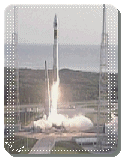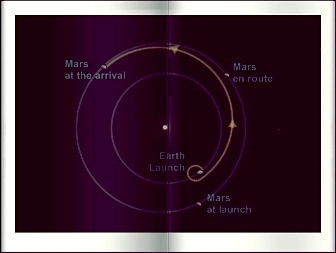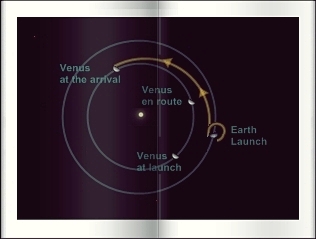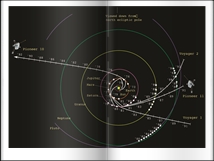
The gravity is one of the four forces of physics. Three of such forces are exerting at very small scales, in the world of particles, like the electromagnetic force or the strong nuclear force, as gravity is the only force exerting over long distances. Gravity decreases with distance. It's Newton, the English 17th century scientist, who theorized gravity. The current way of seeing that force is Einstein's, where each massive celestial body is seen curving the space about it, just like a lead ball deposited on a foam surface. Newtonian laws are still well adapted to space flight however, as craft are orbiting at speeds far from any fraction of the speed of light. The laws of Relativity will apply when future technologies will allow far larger speeds for interstellar journeys
| Orbits at Earth | Interplanetary Orbits |
| Theory The Elements of an Orbit | The Various Types of Earth Orbit |
Any body, due to gravity, is free falling towards Earth, that is it's attracted towards the Earth's center. The object may fall straight forwards, like an object one lets falling, or it may be in a whatever motion, and arcing, like a cannonball. Would, in the second case, the initial speed of the cannonball be sufficient -and the height of the starting point, the canonball would free fall in such a way that its theoretical point of fall would be nowhere at the Earth's surface! It would just be like the Earth was continuously escaping under the cannonball. The cannonball would just be orbiting around the Earth! That example of a canon shot is due to Newton himself, in Book III of the 'Philosophiae Naturalis Principia Mathematica', with the canon situated at a hill top and with the assumption that there is no air friction. This is the basics of space flight. As far as satellites are concerned, the boost is provided by the launcher, as, at the same time, it's bringing the satellite to a sufficient height. 19,000 mph (30,000 km/h) and 120 mi (200 km) in altitude -which are the values already given by Newton- are the sufficient speed and height as the object thus fired is performing one orbit in 84.4 minutes. Launchers are taking advantage of the Earth's rotation, as they mostly launch in the direction of where the launching station is rotating, as taken by the Earth's rotation. Such a configuration is adding to the launch speed. Another way to see why a satellite is orbiting is to say that the satellite's speed is balancing Earth's gravitational force. The speed at which the satellite is orbiting makes that the satellite is pushed away from Earth, while the Earth's gravity is keeping it back. The weightless aboard a spacecraft, as far as it is concerned, is explained by the fact that the astronauts may be considered like independent objects who have been put into orbit with their craft. They are falling at the same speed than their vessel, hence they are floating inside!

About the boundaries of space, varied definitions are at odds together. A broad figure is the 50-mile (80-km) mark, beyond which NASA considers an astronaut anyone who has flown there and the U.S. Army's favorite. The altitude of 62 miles (100 km) is an official definition of space as the Earth's atmosphere there is still thick enough to drag a satellite out of orbit in an hour or two as the air however is so thin that no any kind of aerodynamic lift is provided. The 62-mile boundary, or the Kármán line, is officially accepted by the International Aeronautical Federation (IAF), the organization responsible for setting the aeronautics' standards. The 75.7-mile (122-km) mark (or 400,000 ft) is used by NASA's mission control and flight engineers like the point where the effects of the atmospheric friction and heating becomes observable on a craft re-entering Earth. It's at such an altitude, for example, that the Space Shuttle can switch from its thrusters to its aerodynamical surfaces, reaching what is called the 'entry interface'. A effort during the 1990’s to overcome bureaucratic barriers over the definition of an astronaut which allowed more crew to qualifiy. Due to the residual atmospheric drag like stated above, most satellites are orbiting at 100 miles (160 km) of altitude at least. There is still enough atmosphere there to drag a satellite out in a few days or weeks. The Space Shutlle is usually orbiting at an altitude of 185 miles (300 km). An altitude of 73 miles (118 km) at last, was found, in 2009 to be the point where the breezes of the upper Earth's atmosphere are meeting the solar flow of charged particles. The USA never opted for a set of official space boundaries because it would bring the question of overflight rights by satellites
The theoretical data about a satellite' orbit largely relates to orbits in general (for more, see the tutorial "Orbits"). Most satellites are orbiting counterclockwise as seen from a point located above the Earth's north pole, as most have an elliptical shape, that is they are egg-shaped, with a point nearer to Earth and a point farther. Such points are called the apsides of the orbit. The point nearest Earth is called the "perigee", as the point farthest the "apogee". The "period" is the term used to designate the amount of time it takes to the satellite to achieve one orbit. The orbits of a satellite is defined relatively to a plane of reference. The plane of reference is the Earth's equatorial plane.The "inclination" is how much the plane of the satellite's orbit is tilted compared to the Earth's equatorial plane (the '0' is on the equator, right as the inclination is computed upwards from there, to 90 degrees). The "nodes" are the points where the orbit's plane intersects the Earth's equatorial plane. It's there that the satellite crosses the plane of reference up or down. "Ascending node is for the point where the craft crosses the plane upwards, as "descending node" is for the point where it crosses downwards. The line between both nodes is called the "line of nodes". Due to the second law of Kepler -equal areas are sweeped in equal amounts of time- a satellite is moving more speedily at its perigee, and it's moving more slowly at its apogee. As an orbit is an ellipse, it's a section of a cone, with two focii and two axis. The "major axis" is intersecting the two focii, as the "minor axis" is perpendicular to the previous at the ellipse's center. The "semimajor axis" of the orbit is the average distance from the orbiting body to the central body. As the name tells, it is the half of the major axis. At last, an ellipse may be diversely elongated relative to a perfect circle. The elongation of an orbit is termed its "eccentricity". It's ranging from 0 (the orbit is circular) to > 1 (the orbit is an hyperbola), as 1 is for a parabola. An elliptical orbit has an eccentricity 0 > e < 1. More technically, the eccentricity may be said the ratio of the distance between the foci (d) of the ellipse and the length of the major axis (a): e = d / a
 | click to the orbital data of a artificial satellite |
Such data are found back in the sketch above, a more technical specifications are used. Orbit's semimajor axis is termed "a". Eccentricity is "e". "i" is the orbit's inclination relative to the plane of reference. "x" (which may be said too the "vernal point", or the "first point of the Aries", or "vernal equinox") is this line starting at the main body's center and pointing to the vernal equinox, that is the point of the ecliptic where Sun is seen crossing upwards at the spring equinox (for more see at "Celestial Mechanics Definitions List"). x is part of a three-axis coordinate system applying to the orbit, y being the Earth's polar axis, z the plane of reference. W is the angle between the vernal point and the ascending node. w is the "argument of the perigee", that is the angle from the ascending node to the perigee. n is the "true anomaly", that is the angle from the perigee to such or such position of the satellite
Various types of orbits are used at Earth, depending on the work to achieve. As a satellite is orbiting the Earth, generally, on a given trajectory, the Earth below is keeping its own rotation relatively to that orbit. The geostationary orbit or the "walking orbits" are exceptions, like described below
As Venus, Earth and Mars orbit within a vast dust cloud produced by comets and occasional collisions among asteroids, or the so-called 'zodiacal cloud,' that is limiting sensitivity of astronomy satellites orbiting in the plane of the Earth's orbit; projects are thinking of placing future such mission on more tilted orbits which would have spacecraft spend significant amounts of time above and below the thickest dust. More than 4,800 Earth satellites have been launched since the beginning of the space age. 2,300 are still orbiting today. 1,300 are Russians, 700 Americans, as 8,800 diverse debris are orbiting along. 28 countries and 7 organizations are able to operate satellites. Earth satellites are mainly used for communications, defense, weather, navigation, and Earth and astronomical observations. The so-called 'graveyard orbit' is a high altitude orbit where satellites are moved at the end of their operational life. Small or large-sized miscellaneous objects, or 'space debris,' as remainders of the space conquest, are still orbiting around Earth, like bolts, chips of paints, remains of launches, or satellites having ended their life, etc. They all represent a danger for current satellites or missions due to their speed of about 17,500 mph (28,100 km/h). Space debris today amount to 23,000 tracked debris, 750,000 pieces larger than 0.4 inch and 166 million larger than 1 line. Orbital debris as small as .3 line may pose a danger to human spaceflight and robotic missions as pieces smaller than 0.4 inches (1cm) are hard to spot using radar. More than 22,000 space debris are monitored by the U.S. Space Surveillance Network which can't watch them all. Some 95 percent of all objects in orbit are dead satellites or pieces of inactive one. Militaries worldwide, on the other hand, omit giving details about their satellites debris. In 2017, commercial companies, military and civil departments and amateurs were forced to loft more than 400 satellites into orbit, over 4 times the yearly average for 2000–2010. Orbital debris reached to a peak due to Chinese blowing up in 2007 one of their satellites in a missile test, and the 2009 Iridium–Cosmos collision. Space sustainability since the 2000's turned a preoccupation of space users. Such objects are termed 'MMOD' for 'micrometeoroids and orbital debris' as medium-sized ones, at a diameter 0.4 to 4 inches pose the greatest threat because they are the less trackable. More than 75 percent of trackable space debris whizzes around in Earth’s heavily trafficked low orbits, below 1,250 km altitude as the number of debris keeps rising as driven by continuing collisions. Once each day, the Joint Space Operations Center (JSpOC) at Vandenberg Air Force Base in California analyzes the updated orbits, looks for possible conjunctions (the name for a close approach) a week or more into the future, and notifies the NASA's Robotic Conjunction Assessment Risk Analysis (CARA) team based at NASA's Goddard Space Flight Center of any events involving NASA's robotic missions. Another group at NASA's Johnson Space Flight Center in Houston performs the same function for all spacecraft carrying astronauts, including the International Space Station. Satellites which can afford, are using avoidance maneuvers against the threat. When Sun is reaching a active period, Earth's atmosphere expands in height, which increases orbital drag for high-orbiting debris, causing them to reach lower. The U.S. Department of Defense (DoD) and NASA had conducted some laboratory-based impact tests in the past, with, for example, breakup models like Satellite Orbital debris Characterization Impact Test (SOCIT) in the 1990's. Current satellites features many different technologies compared to that time and NASA is to resume ground collision tests to improve its understanding of how new materials and techs brake apart. A way nowadays to dodge a impact consists in modifying the orbit of any satellite concerned. The U.S. Air Force is scheduled to use a new powerful new radar facility on Kwajalein in the Pacific Ocean, allowing the US military to detect smaller objects still than today’s 10-centimetre limit
A journey to another planet of the solar system is nothing more but a orbit. The orbit is about the Sun instead of the Earth however. The interplanetary probes are using two kinds of orbit to reach their target. Either Hohmann transfer orbits, or gravity assist trajectories. The craft star tracker system takes images of stars and compares them to a on-board catalog, which then tells the spacecraft navigation systems its attitude, or which way it is pointing
| Hohmann Transfer Orbits Gravity Assist Trajectories | Deceleration, Various Orbits |
 | NASA' Mars-bound mission launching atop a Lockheed Martin Atlas V from the Kennedy Space Center (August 2005). picture NASA/KSC |
A Hohmann transfer orbit is mostly used for Mars and for the planets which are located between the Sun and the Earth, like Venus and Mercury. Such a course is having the mission, finally, behaving like a planetary object in orbit around the Sun! As far as a journey to Mars is concerned, the craft is raised into an Earth orbit. From there, it's given a boost which is directed along the motion of the Earth's on its orbit. The probe, thus, comes to move faster than the Earth, at about 21 miles per second (instead of 19 miles per second for the Earth). Hence its orbit gets distant from Earth's! The probe's orbit eventually reaches the orbit of Mars! A Trajectory Correction Maneuver however is performed early during a mission to Mars to avoid that the craft just circles the Sun. For the MRO mission to Mars, which launched in 2005, for example, this first and largest maneuver consisted of a 44.5-second firing of the engines. The relative positions of the Earth and Mars, generally, are most favorable for launching missions
from Earth to Mars for only a few weeks every 26 months
In the case when Venus is the target, the craft is just given a boost directed at the opposite of Earth's motion. The craft, thus, slows down, by about 17 miles per second. Hence it falls on a tighter orbit than Earth's, as it eventually reaches the orbit of Venus. On the other hand, as far as Mercury is concerned, despite that it's being much closer to Earth, it is actually more difficult to reach as, to enter orbit, a space probe has to constantly brake against the strong gravitational pull of our Sun. In both case of Mars and Venus, the launch time is taking in account the relative positions of both the Earth and the planet, in such a way that the probe reaches the planet in due time. Theoretically a Hohmann transfer orbit is an orbit, periapsis of which is much closer to the Sun than the apoapsis is. Such orbits were theorized in the 1920s by Walter Hohmann, a German scientist. Best launch opportunities to Mars comes every 26 months about the moment when Mars is at opposition


The gravity-assisted trajectories have been devised in the 1960s by the people at the JPL as one had noticed that any planetary mission, outwards bound from the Sun was ineluctably braked on its journey by the gravitational pull of it. To avoit that, the principle is that one borrows some angular momentum at one or more planets. The craft is catching the targeted planet from behind like it would do if it was arriving there on a Hohmann orbit. Due to its strong interplanetary speed the craft is not captured in orbit. It just flies by the planet -hence the name and verb: "flyby", to "flyby". Due to that the planet is moving on its orbit, the flyby just adds the speed of the planet to the initial speed of the craft. The planet is acting like a slingshot to the probe. Planets like Jupiter and Saturn are adding about 12.5 miles per second (20 km/s), as Uranus and Neptune are about 6.2 (10 km/s) or Earth 1.9 (3.1 km/s). Flybys may be used at inner planets too, like Venus or Mercury. In this case, gravity-assisted trajectories are used for orbiters, as a way to keep the craft velocity at a reasonable pace. The first gravity assists are used to send the craft towards the orbit of its targeted planet- as the following ones are used to reduce its speed at the effect it eventually matches the one of the planet, allowing for the final capture. The craft otherwise would have to carry an enormous amount of fuel to perform an insertion burn, and would hence require a much larger launch vehicle. Flybys are also a way to modify the direction of where the craft is going, as the planet's gravity field is deflecting the trajectory. Gravity assist trajectories are a way to travel far and cheap. A gravity assist trajectory always begins with a Hohmann transfer orbit, inbound, or outbound to some inner or outer planet. Trajectories are of Type-I or of Type-II whether the craft's orbit takes it less or more than 180° around the Sun. On the other hand, at last, such slingshots trajectories, when used to reach an orbit around an outer planet, serve too to avoid an excessive speed of the craft at its arrival. A direct flight would reach the target with such a speed that no engine burn could brake it enough. The craft would just flyby!
Gravity-assist maneuvers can be used to speed a spacecraft up or slow a spacecraft down. Closest approach distance, direction, and the speed of a spacecraft relative to the planet’s speed all affect the acceleration and direction change of the spacecraft’s trajectory. The greatest change in a spacecraft’s speed and direction occurs when a slow-moving spacecraft approaches just above the surface or cloud tops of a massive planet. The least change in a spacecraft’s speed and direction occurs when a fast-moving spacecraft approaches a small planet from a great distance
When the mass of a planetary object, for example, is not precisely known when launching the mission, the trajectory is computed just to bring the spacecraft into the vicinity of the target and further refined once the mass is known. This often is the case for missions aiming at comets. Relativity-related value are to be added to the computing of the orbit of a mission which is closing large-mass objects, like the Sun, for example, as the discrepancies of Einstein's relativistic concept of gravity compared to Newton's and Kepler's mathematical laws become noticeable (as they're not for most of the missions). A real cosmic mystery for flybys at Earth is that engineers have measured a anomaly which can, or not, affect a mission, like a strange, tiny variation in the amount of expected speed gained (or lost) during the passage
A technique called a 'pi transfer,' on a other hand, uses the gravity of a planet's moon to alter the orbit of a spacecraft so it can gain different perspectives on the planet
->The Neat Orbital Budget for A Planet of A Gravity-Assisted Flyby!
Orbitally speaking, a gravity-asssited flyby is not neutral from the point of view of the planet used, as it's slightly slowed on its orbit. In the case of a flyby at Mars, for example, the brake is of the order of 1 atom after one year following the flyby. After 180 million years, this amounts to a shift of one inch (2.5 centimeters) on the orbit!
 | click to Pioneers and Voyagers gravity assist trajectories. picture courtesy NASA/KSC |
Whatever type of orbit an interplanetary mission is using, it has to decelerate at arrival in case it has to be captured into orbit around the target planet or to land on it. Unless, the craft would just pass by the planet. Such decelerating maneuvers may be performed in various ways like an engine burn, or the use of the body's upper atmosphere to brake the craft ("aerobraking"). When the craft is to land on the planet, like often the case at Mars, it's provided with a heat shield and it is just braked by the planet's atmosphere. Parachutes further slow down the final phases of the descent. When the craft is an orbiter due to stay in orbit around the planet, the arrival is usually done through an engine burn which is slowing the craft from its interplanetary speed, allowing it to be captured by the planet's gravitational field. Aerobraking, which is using a craft with a protective shield and the drag of the planet's upper atmosphere, is another way to achieve orbit. The craft just grazes the planet's atmosphere several times in a preparatory orbit and it's raised again to its final trajectory when the planned orbit has been reached. Some of the various Earth orbits as seen above are used too by interplanetary missions. Polar and Sun synchronous orbits, for examples, are used for mapping and monitoring missions. Sun synchronous orbits are allowing pictures to always have the same orientation of the shadows as the craft passes over the same part of the planet its circles, at roughly the same local time each day. Such a Sun-synchronous orbit may be shifted toward such or such time of the day. 206 Moon and interplanetary missions worldwide have been launched since the beginnings of the space age
Website Manager: G. Guichard, site 'Amateur Astronomy,' http://stars5.6te.net. Page Editor: G. Guichard. last edited: 9/5/2018. contact us at ggwebsites@outlook.com